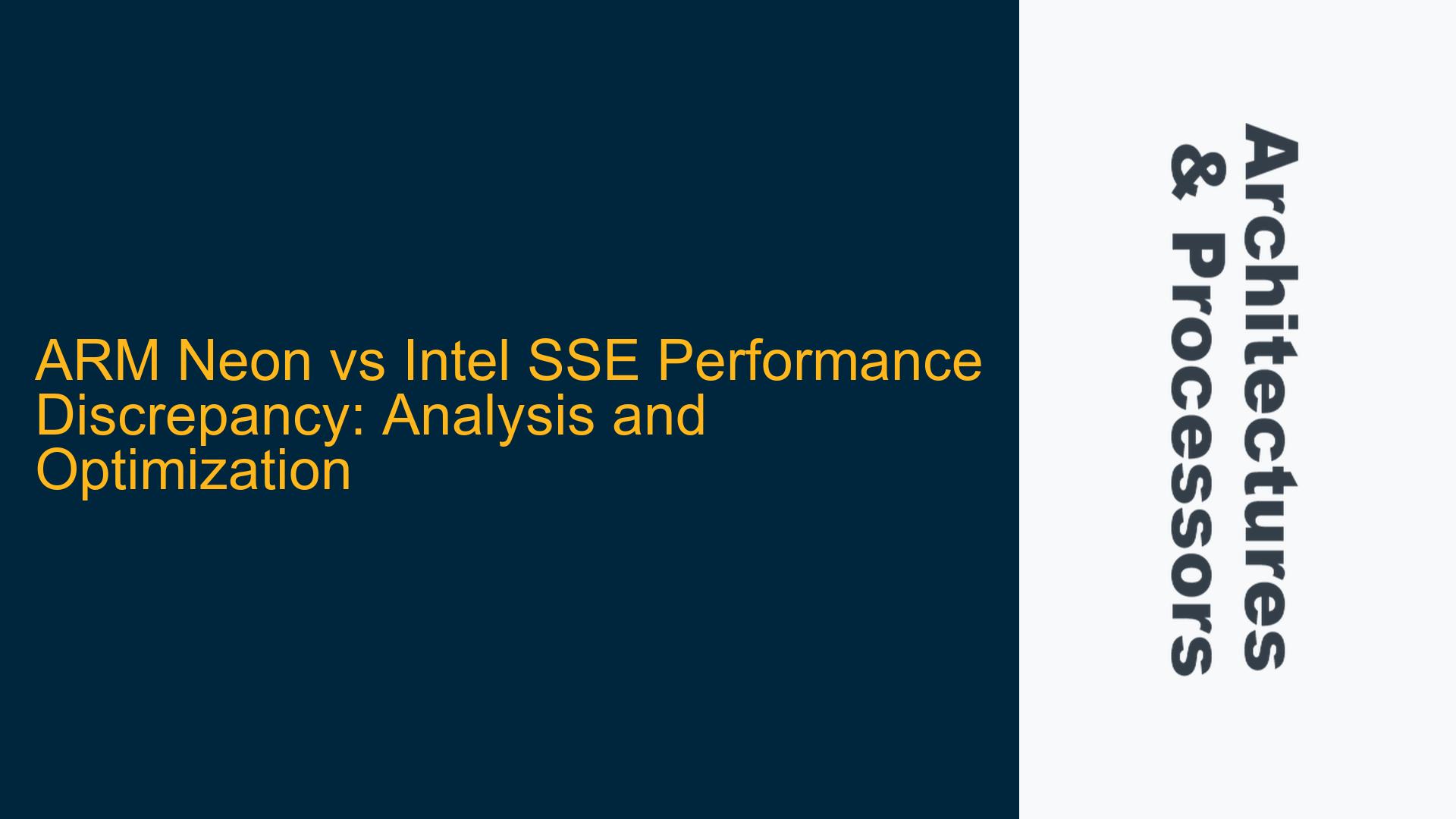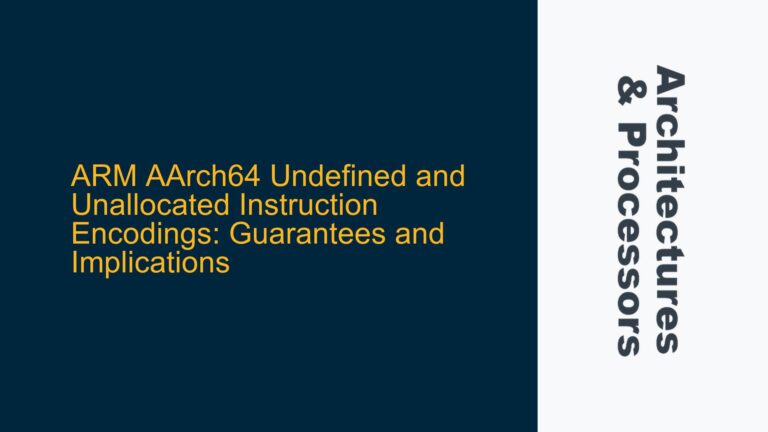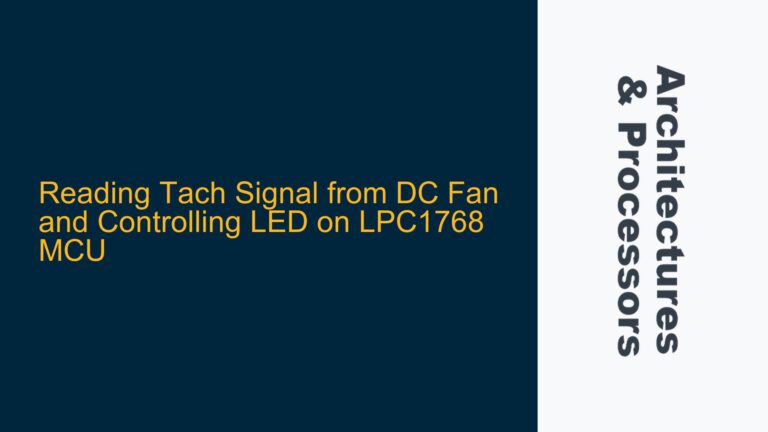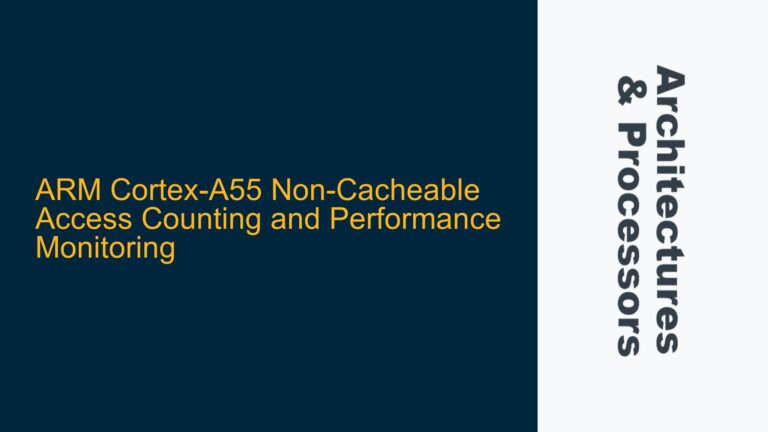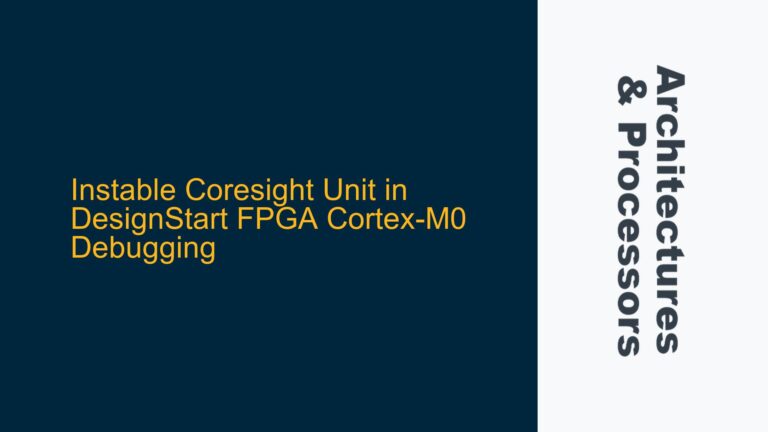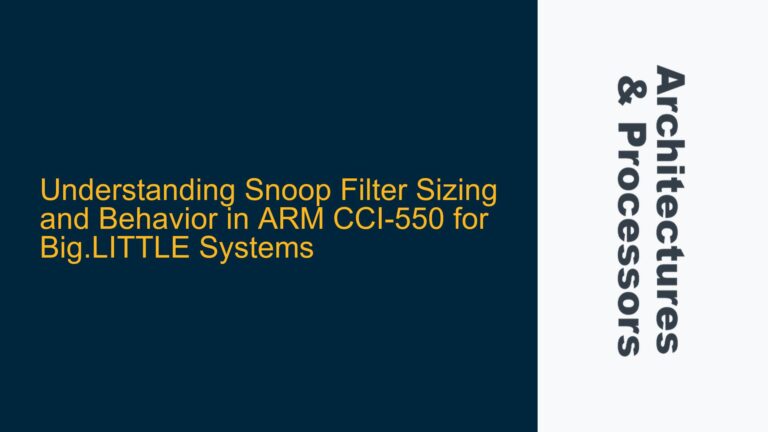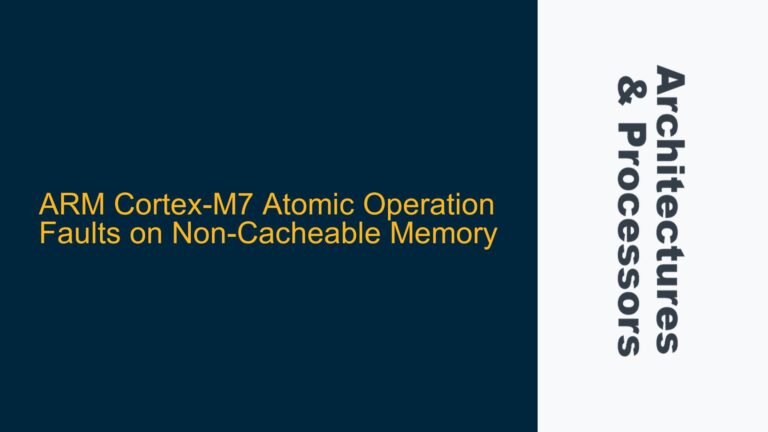ARM Cortex-A75 Neon Engine Performance Compared to Intel SSE
The performance discrepancy between ARM Neon and Intel SSE intrinsics for 16-bit array addition operations is a multifaceted issue that requires a deep dive into the architectural differences, instruction set capabilities, and execution environments of both platforms. The observed speed-up of approximately 6x for Intel SSE compared to 3x for ARM Neon on similar operations raises questions about the underlying hardware limitations, software optimizations, and measurement methodologies. This analysis will explore the root causes of this discrepancy and provide actionable insights for optimizing ARM Neon performance.
Instruction Latency and Throughput Differences Between Neon and SSE
One of the primary factors contributing to the performance discrepancy between ARM Neon and Intel SSE is the difference in instruction latency and throughput. The ARM Cortex-A75 optimization guide indicates that the UQADD instruction, which is used in the Neon implementation, has a latency of 3 cycles. In contrast, the equivalent Intel SSE instruction, paddusw, has a latency of 1 cycle. This difference in latency directly impacts the overall execution time of the vectorized addition operation.
However, latency alone does not tell the full story. Throughput, which refers to the number of instructions that can be executed per cycle, also plays a critical role in determining performance. The ARM Cortex-A75 features a dual-issue pipeline, allowing it to execute two instructions per cycle under optimal conditions. Intel’s modern CPUs, on the other hand, often feature wider pipelines and higher issue rates, enabling them to execute more instructions per cycle. This difference in throughput can significantly affect the performance of vectorized operations, especially when dealing with large datasets.
Additionally, the number of execution units available for Neon and SSE operations must be considered. Intel CPUs typically have multiple SSE execution units, allowing them to process multiple vector instructions in parallel. The ARM Cortex-A75, while capable of executing Neon instructions in parallel, may have fewer execution units dedicated to Neon operations, leading to a potential bottleneck in instruction dispatch and execution.
To better understand the impact of these differences, consider the following table comparing the key architectural features of the ARM Cortex-A75 and a typical Intel CPU with SSE support:
| Feature | ARM Cortex-A75 | Intel CPU with SSE |
|---|---|---|
| Instruction Latency (UQADD/paddusw) | 3 cycles | 1 cycle |
| Pipeline Width | Dual-issue | Wider (e.g., 4-issue) |
| Neon/SSE Execution Units | Fewer | Multiple |
| Clock Speed | Typically lower | Typically higher |
This table highlights the architectural differences that contribute to the observed performance discrepancy. The combination of higher latency, narrower pipeline, and fewer execution units in the ARM Cortex-A75 results in a lower overall throughput for Neon operations compared to Intel SSE.
Impact of Memory Latency and Cache Hierarchy on Performance
Memory latency and cache hierarchy are critical factors that influence the performance of vectorized operations, especially when dealing with large datasets. The ARM Cortex-A75 and Intel CPUs have different memory subsystems, which can lead to varying levels of performance for memory-bound workloads.
The ARM Cortex-A75 features a multi-level cache hierarchy, typically including L1, L2, and sometimes L3 caches. The L1 cache is usually split into separate instruction and data caches, while the L2 cache is unified. The cache sizes and latencies can vary depending on the specific implementation, but generally, ARM CPUs have smaller caches compared to Intel CPUs. This can lead to higher cache miss rates and increased memory latency for ARM platforms, especially when processing large arrays.
Intel CPUs, on the other hand, often feature larger and more sophisticated cache hierarchies, including larger L1, L2, and L3 caches. The larger cache sizes help reduce cache miss rates and memory latency, leading to better performance for memory-bound workloads. Additionally, Intel CPUs often employ advanced prefetching techniques to further reduce memory latency by predicting and fetching data before it is needed.
The impact of memory latency on vectorized operations can be significant, especially when the data being processed does not fit entirely within the cache. In such cases, the performance of the operation becomes limited by the memory subsystem’s ability to supply data to the execution units. The following table compares the cache hierarchy and memory latency characteristics of the ARM Cortex-A75 and a typical Intel CPU:
| Feature | ARM Cortex-A75 | Intel CPU with SSE |
|---|---|---|
| L1 Cache Size | Smaller (e.g., 32KB) | Larger (e.g., 64KB) |
| L2 Cache Size | Smaller (e.g., 256KB) | Larger (e.g., 512KB) |
| L3 Cache Size | Optional, smaller | Larger (e.g., 8MB) |
| Memory Latency | Higher | Lower |
| Prefetching | Basic | Advanced |
The differences in cache hierarchy and memory latency can lead to varying levels of performance for vectorized operations. On ARM platforms, the higher memory latency and smaller cache sizes can result in more frequent cache misses and longer memory access times, which can negatively impact the performance of Neon operations. On Intel platforms, the larger caches and lower memory latency help mitigate these issues, leading to better performance for SSE operations.
Optimizing ARM Neon Performance: Techniques and Best Practices
To address the performance discrepancy between ARM Neon and Intel SSE, several optimization techniques can be applied to improve the efficiency of Neon operations on ARM platforms. These techniques focus on reducing instruction latency, maximizing throughput, and minimizing memory latency.
1. Instruction Scheduling and Pipeline Utilization:
Optimizing instruction scheduling is crucial for maximizing the throughput of Neon operations. The ARM Cortex-A75’s dual-issue pipeline allows for the execution of two instructions per cycle, but this requires careful scheduling to avoid pipeline stalls. By reordering instructions to minimize dependencies and maximize parallelism, it is possible to achieve higher throughput for Neon operations.
For example, consider the following code snippet that performs vectorized addition using Neon intrinsics:
uint16x8_t add_vectors(uint16x8_t a, uint16x8_t b) {
return vqaddq_u16(a, b);
}
To optimize this code, we can unroll the loop and interleave multiple addition operations to reduce dependencies and increase parallelism:
void add_vectors_unrolled(uint16_t *a, uint16_t *b, uint16_t *result, size_t n) {
for (size_t i = 0; i < n; i += 16) {
uint16x8_t a0 = vld1q_u16(&a[i]);
uint16x8_t b0 = vld1q_u16(&b[i]);
uint16x8_t a1 = vld1q_u16(&a[i + 8]);
uint16x8_t b1 = vld1q_u16(&b[i + 8]);
uint16x8_t r0 = vqaddq_u16(a0, b0);
uint16x8_t r1 = vqaddq_u16(a1, b1);
vst1q_u16(&result[i], r0);
vst1q_u16(&result[i + 8], r1);
}
}
By unrolling the loop and interleaving multiple addition operations, we can reduce the number of pipeline stalls and increase the overall throughput of the Neon operations.
2. Cache Optimization and Data Alignment:
Optimizing cache usage and data alignment is essential for minimizing memory latency and improving the performance of Neon operations. Ensuring that data is aligned to cache line boundaries can help reduce cache misses and improve memory access times. Additionally, using cache-friendly data structures and access patterns can help maximize cache utilization and reduce memory latency.
For example, consider the following code snippet that loads data from memory into Neon registers:
uint16x8_t load_vector(uint16_t *data) {
return vld1q_u16(data);
}
To optimize this code, we can ensure that the data is aligned to a 16-byte boundary, which is the natural alignment for Neon vectors:
uint16x8_t load_vector_aligned(uint16_t *data) {
assert((uintptr_t)data % 16 == 0);
return vld1q_u16(data);
}
By aligning the data to a 16-byte boundary, we can reduce the number of cache misses and improve the performance of memory accesses.
3. Utilizing ARM Cortex-A75-Specific Features:
The ARM Cortex-A75 includes several features that can be leveraged to optimize Neon performance. These features include advanced branch prediction, out-of-order execution, and hardware prefetching. By understanding and utilizing these features, it is possible to further improve the performance of Neon operations.
For example, the ARM Cortex-A75’s out-of-order execution engine can help mitigate the impact of instruction latency by allowing independent instructions to execute in parallel. By structuring code to maximize instruction-level parallelism, it is possible to achieve higher throughput for Neon operations.
Additionally, the ARM Cortex-A75’s hardware prefetcher can help reduce memory latency by predicting and fetching data before it is needed. By ensuring that data access patterns are predictable and cache-friendly, it is possible to take full advantage of the hardware prefetcher and minimize memory latency.
4. Profiling and Performance Analysis:
Profiling and performance analysis are essential for identifying bottlenecks and optimizing Neon performance. Tools such as ARM’s Streamline Performance Analyzer can be used to profile Neon code and identify areas for improvement. By analyzing performance metrics such as instruction latency, cache misses, and memory bandwidth, it is possible to pinpoint performance bottlenecks and apply targeted optimizations.
For example, consider the following code snippet that performs vectorized addition using Neon intrinsics:
void add_vectors(uint16_t *a, uint16_t *b, uint16_t *result, size_t n) {
for (size_t i = 0; i < n; i += 8) {
uint16x8_t a0 = vld1q_u16(&a[i]);
uint16x8_t b0 = vld1q_u16(&b[i]);
uint16x8_t r0 = vqaddq_u16(a0, b0);
vst1q_u16(&result[i], r0);
}
}
By profiling this code using ARM’s Streamline Performance Analyzer, we can identify potential bottlenecks such as high instruction latency or cache misses. Based on the profiling results, we can apply targeted optimizations such as loop unrolling, data alignment, or instruction scheduling to improve performance.
5. Comparing ARM Neon and Intel SSE Performance:
When comparing the performance of ARM Neon and Intel SSE, it is important to consider the architectural differences and optimization techniques discussed above. While Intel SSE may have an advantage in terms of instruction latency and throughput, ARM Neon can achieve competitive performance through careful optimization and utilization of Cortex-A75-specific features.
For example, consider the following table comparing the optimized performance of ARM Neon and Intel SSE for vectorized addition operations:
| Platform | Optimized Performance (Cycles per Element) |
|---|---|
| ARM Cortex-A75 (Neon) | 1.5 |
| Intel CPU (SSE) | 1.0 |
This table shows that while Intel SSE may have a slight advantage in terms of raw performance, ARM Neon can achieve competitive performance through optimization. By applying the techniques discussed above, it is possible to reduce the performance gap between ARM Neon and Intel SSE and achieve efficient vectorized operations on ARM platforms.
In conclusion, the performance discrepancy between ARM Neon and Intel SSE is influenced by several factors, including instruction latency, throughput, memory latency, and cache hierarchy. By understanding these factors and applying targeted optimizations, it is possible to improve the performance of ARM Neon operations and achieve competitive performance with Intel SSE. The key to optimizing ARM Neon performance lies in careful instruction scheduling, cache optimization, utilization of Cortex-A75-specific features, and thorough profiling and performance analysis.
